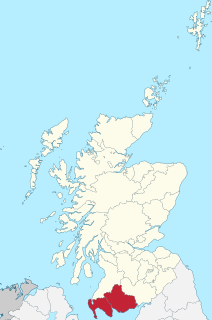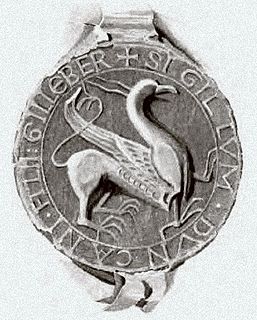
William the Lion, sometimes styled William I, also known by the nickname Garbh, "the Rough", reigned as King of Scots from 1165 to 1214. He had the second-longest reign in Scottish history before the Act of Union with England in 1707. James VI would have the longest.

Galloway is a region in southwestern Scotland comprising the historic counties of Wigtownshire and Kirkcudbrightshire.

Earl of Carrick or Mormaer of Carrick is the title applied to the ruler of Carrick, subsequently part of the Peerage of Scotland. The position came to be strongly associated with the Scottish crown when Robert the Bruce, who had inherited it from his maternal kin, became King of the Scots in the early 14th century. Since the 15th century the title of Earl of Carrick has automatically been held by the heir apparent to the throne, meaning Prince Charles is the current Earl.
The sovereign or feudal lordship of Argyle was the holding of the senior branch of descendants of Somhairle, this branch becoming soon known as Clan MacDougall

The lords of Galloway consisted of a dynasty of heirs who were lords and ladies who ruled over Galloway in southwest Scotland, mainly during the High Middle Ages. Many regions of Scotland, including Galloway and Moray, periodically had kings or subkings, similar to those in Ireland during the Middle Ages. The Scottish monarch was seen as being similar to a high king. The lords of Galloway would have either paid tribute to the Scottish monarch, or at other times ignored him. The Lords of Galloway are fairly well recorded in the 12th and 13th centuries, but the records are incomplete or conflicting at other times. Later on, the kings were known as "lords" at the Scottish court, and "kings" at home, finally becoming "lords" in both arenas.
Lochlann, also known by his French name Roland fitz Uhtred, was the son and successor of Uchtred, Lord of Galloway as the "Lord" or "sub-king" of eastern Galloway.
Gille Brigte or Gilla Brigte mac Fergusa of Galloway, also known as Gillebrigte, Gille Brighde, Gilbridge, Gilbride, etc., and most famously known in French sources as Gilbert, was Lord of Galloway of Scotland. Gilla Brigte was one of two sons of the great Fergus, the builder of the "Kingdom" of Galloway.

Donnchadh was a Gall-Gaidhil prince and Scottish magnate in what is now south-western Scotland, whose career stretched from the last quarter of the 12th century until his death in 1250. His father, Gille-Brighde of Galloway, and his uncle, Uhtred of Galloway, were the two rival sons of Fergus, Prince or Lord of Galloway. As a result of Gille-Brighde's conflict with Uhtred and the Scottish monarch William the Lion, Donnchadh became a hostage of King Henry II of England. He probably remained in England for almost a decade before returning north on the death of his father. Although denied succession to all the lands of Galloway, he was granted lordship over Carrick in the north.

Dervorguilla of Galloway was a 'lady of substance' in 13th century Scotland, the wife from 1223 of John, 5th Baron de Balliol, and mother of John I, a future king of Scotland.
Galwegian Gaelic is an extinct dialect of the Goidelic languages formerly spoken in southwest Scotland. It was spoken by the people of Galloway and Carrick until the early modern period. It was once spoken in Annandale and Strathnith. Little has survived of the dialect, so that its exact relationship with other Goidelic languages is uncertain.
The Mormaerdom or Kingdom of Moray was a lordship in High Medieval Scotland that was destroyed by King David I of Scotland in 1130. It did not have the same territory as the modern local government council area of Moray, which is a much smaller area, around Elgin. The medieval lordship was in fact centred on both the lower Spey valley and the environs of Inverness and the northern parts of the Great Glen, and probably originally included Buchan and Mar, as well as Ross.
The Kingdom of Alba refers to the Kingdom of Scotland between the deaths of Donald II in 900 and of Alexander III in 1286, which then led indirectly to the Scottish Wars of Independence. The name is one of convenience, as throughout this period the elite and populace of the Kingdom were predominantly Pictish-Gaels or later Pictish-Gaels and Scoto-Norman, and differs markedly from the period of the Stuarts, in which the elite of the kingdom were speakers of Middle English, which later evolved and came to be called Lowland Scots. There is no precise Gaelic equivalent for the English terminology "Kingdom of Alba", as the Gaelic term Rìoghachd na h-Alba means 'Kingdom of Scotland'. English-speaking scholars adapted the Gaelic name for Scotland to apply to a particular political period in Scottish history during the High Middle Ages.

Alan Hostarius was the son of Thomas de Lundin, a grandson of Gille Críst, Mormaer of Mar. His mother's name is unknown, but she was almost certainly a daughter of Máel Coluim, Mormaer of Atholl, meaning that Alan was the product of two Gaelic comital families.

Gilbert was a 13th-century Cistercian monk, abbot and bishop. His first appearance in the sources occurs under the year 1233, for which year the Chronicle of Melrose reported that "Sir Gilbert, the abbot of Glenluce, resigned his office, in the chapter of Melrose; and there he made his profession". It is not clear why Gilbert really did resign the position of Abbot of Glenluce, head of Glenluce Abbey in Galloway, in order to become a mere brother at Melrose Abbey; nor is it clear for how long Gilbert had been abbot, though his latest known predecessor is attested last on 27 May 1222. After going to there, Gilbert became the Master of the Novices at Melrose.
Aodh Méith or Áed Méith was a 13th-century king of Tír Eoghain. The son of Aodh an Macaoimh Tóinleasg, Aodh spent much of his career fighting off threats from Fir Manach, Tír Conaill and Galloway, as well as John de Courcy and the Lordship of Ireland. His involvement in Irish Sea politics may have seen him sponsor a Mac Uilleim claim to the Scottish throne, but this is unclear.
The Galloway revolt of 1234—35 was an uprising in Galloway during 1234—35, led by Tomás mac Ailein and Gille Ruadh. The uprising was in response to the succession of Alan of Galloway, whereby King Alexander II of Scotland ordered Galloway to be divided the amongst Alan's three heiresses under Norman feudal law. This judgement excluded Alan's illegitimate son Tomás, who believed he was the rightful heir under the Gaelic system of tanistry. Alexander II responded by leading an army into Galloway to crush the rebellion. The Scottish army was almost routed, however was saved by the arrival of Fearchar, Earl of Ross and his forces. Walter Comyn, Lord of Badenoch was left to mop up the revolt, however was forced to abandon the region. Patrick II, Earl of Dunbar led another army in 1235, with Adam, Abbot of Melrose, and Gilbert, Bishop of Galloway and forced the submission of Tomás and Gille.
















